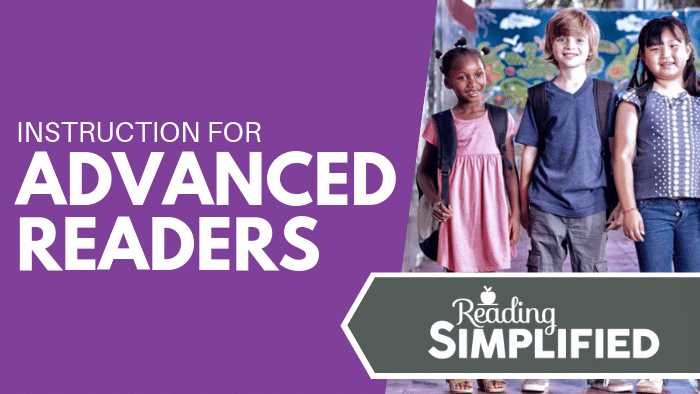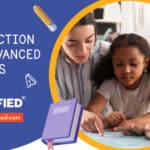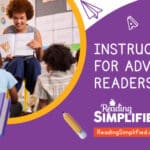
We talk about beginners and struggling readers a lot here on Reading Simplified. But not all kids struggle to get the code. Some readers accelerate faster than other members of the classroom, and it’s important to support this rapid growth so that they can become even better readers.
We need to think about our readers and the stage they’re currently in. After all, not every student needs the same level of instruction, which is why we have to refine our teaching methods so that we get more out of that instructional time.
In this blog post, we’re going to talk about guided reading instruction for high flyer students.
{To watch a video where I discuss this topic hit play below, or read on for a detailed overview}
A Developmental Model of Reading for Instruction
Here is a model of reading development. If you look at it carefully, you’ll be able to I pinpoint precisely where you think your kids are in the diagram:

As you can see, time is represented by the arrow running along the bottom of the image. As your readers progress from beginners to more advanced, you can move them across the page from left to right.
Everything you see in the center of the model is surrounded by a big blue ocean that represents comprehension and vocabulary. The first giant domain we need to work on is decoding because you need an excellent decoding foundation to be a good reader. Up next are those high-frequency words we all know and love. It’s an important instructional element and integrates with fluency.
As kids progress, you can begin adding more high-frequency words. When decoding and fluency are well established, you can start emphasizing affixes and roots (such as prefixes and suffixes).
Readers will continue to advance until you shift the focus more on comprehension and vocabulary, which is advanced literacy.
In the early stages of reading, you provide students with the basics of the English language. But, if you want them to become sophisticated readers and thinkers, they need to learn a lot more about comprehension and vocabulary.
The Role of Motivation & Engagement
How many times have you been in the middle of teaching your students and noticed a few at the back starting to doze off?
Maybe they don’t want to engage with the lesson, or they’re expressing some resistance to reading?
What can you do to help engage and motivate your students?
First, consider your students most pressing need and then choose an instructional activity based on the need of motivation to help reboot their interest.
Remember – motivation and engagement need to take the precedence when we make instructional decisions. If our student’s motivation starts to dip, we’re in trouble!
Without motivation, students won’t want to engage with the lesson and will begin to resist. So, it’s up to you to re-engage them and help create a love of reading that they’ll carry with them throughout their lives.
Instructional Reading for Basic Literacy
At the basic literacy stage, much of the reading instruction is focused on decoding. At Reading Simplified, this is the stage where we focus on core activities designed to help kids decode and become fluent readers rapidly.
Our decoding activities include Switch it, Read It, Sort It, Guided Reading (mostly decodable texts) and Write It.
However, you should also pay attention to developing your student's comprehension and vocabulary in the early stages of decoding.
Before we explore instructional reading for advanced literacy, let’s take a look at the activities that help build the blocks of comprehension and vocabulary at the basic literacy stage:
- Interactive Read Aloud
- Listening Along
- Shared Reading
- Independent Reading
- Paired Reading
- Retelling Center
- Readers’ Theater
But what will you (the teacher) do with advanced readers?
Let’s find out!
Instructional Reading for Advanced Literacy
When your students move towards advanced literacy, you’ve got to up the ante and focus a lot of instructional time on expanding comprehension and vocabulary.
The main activities you’ll focus on with advanced readers include:
- Some Word Study
- Some Fluency-Building
- Guided Reading: comprehension focus
- Wide Independent Reading
When you have strong readers in your classroom, it’s important to encourage them to keep reading and to read more difficult texts.
Introduce them to both fiction and non-fiction books and let them engross themselves in their reading. After all, the more they read, the more they’ll learn about the world around them!
Nonsense Reading Test to Check Sound-Based Decoding Skills
A word of caution! Some of your students may be at this advanced literacy level, but they could also have weak sound-based decoding. What’s likely to have carried them this far is their super strong sight vocabulary and excellent visual memory skills.
If you’re worried that a student may have weak sound-based decoding, you can do a quick check with a nonsense word test. The test will be able to tell you whether or not they’re having issues, which is important to detect as early as possible. The reason for this is due to the fact that as the student progresses to higher reading levels, they’ll encounter more multi-syllable words and may not have the system in place to tackle such words.
What to do for Advanced Literacy Kids?
Let’s get back into the type of things you should be doing to nurture and help those kids at an advanced literacy grow even more…
First, let’s talk about comprehension focused strategies:
Summarization
This is one of the most important things for readers to comprehend.
Learning how to summarize text that they have read helps students learn how to discern key ideas from irrelevant information. Give your kids something that’s challenging for them to read and ask them to summarize it. This will help support them in their understanding of a passage or piece of text.
Comprehension Strategies
Increase comprehension skills by focusing on comprehension strategies such as the strategy of making a prediction and metacognition practice.
Metacognition strategies help students better understand the way they learn and encourages them to “think about their thinking” to help enhance their comprehension skills.
Text Types
Introducing a variety of different text types is one of the best ways to streamline kid’s understanding of comprehension. Some examples include text that only lists details, compare and contrast text and chronologies.
More Non-Fiction
Throw some more non-fiction texts into the mix because that’s the type of reading material that pushes kid’s brains, broadens their minds and enhances their vocabulary!
Writing
Writing is a great developer of comprehension. If you can read something and then respond expressively in writing about it, it shows that you’ve reached a high level of comprehension and understanding.
Research Projects
Advanced readers can have a lot of fun with research projects. They can explore an interesting topic by reading about it and putting the information together in a creative way that helps to improve their critical thinking and writing skills.
Book Clubs/ Literacy Circles
Book clubs and literacy circles are great for advanced readers to explore more challenging texts in a social group setting. It also gives them a chance to discuss what they’ve read and vocalize their thoughts and opinions to other students in the reading group.
Create a Love of Reading!
When you’ve got advanced readers in your classroom, it’s important to try and increase their love for reading. You can do this by encouraging them to read more widely by selecting books that they find interesting, increasing their exposure to different genres and get them to do it a lot!
If you want to learn more about instruction for advanced readers and get your hands on our ‘Developmental Model of Reading for Instruction’ freebie, just sign up below and we’ll send the FREE downloadable PDF straight to your inbox!




Thanks for the the freebie!
May it serve your readers well! 🙂
Looking for texts and activities for two third-graders who love dragons and hate writing. They need some help with sentence construction. They are very imaginative and could write some stories for less advanced readers. I am slowly teaching morphology to them and they are familiar with Greek and Roman myths. Ideas?
Are you looking for a writing program? Home – IEW uses reading passages that students retell and rewrite. They learn how to write a key word outline from which they retell the passage and write it in their own words. With each new assignment, they learn a new writing technique. Sentence construction is taught gently within a paragraph structure. IEW has two methods – in one, they watch videos with the founder teaching them. In the other, the theme-based, the instructor first learns the program and then uses theme-based materials to teach students. IEW_Pathway.pdf Third graders would be considered Level A. One of the theme-based books in Level A is called Fables, Myths, and Fairy Tales. This might fit these two students.
Great article & video! I love the big picture overview. My 16 year old ADHD son really struggled with reading early on,but is now fluent and 11th grade reading level and writing papers well (he is taking dual credit college classes and excelling). However, he has NO interest in reading and never reads of his own accord. He has a difficult time remembering what he reads, due to focus issues. Although he summarizes well, he says it’s challenging. This summer, I plan to ask him to spend some dedicated time each day reading and summarizing a text. I was also thinking about introducing him to some speed reading app activities, do you have any thoughts on these?
Yes, I think that’s a perfect summer activity for him. I have taught several middle/high school boys how to read and then I had to teach them to pay attention to what they were reading, for comprehension’s sake. I just had them read short articles/essays and answer MC questions. Their comp. problems were solved so quickly this way I assumed it meant they just needed to develop a new mental discipline.
If he’s slow with recognizing words, then a speed reading app like Accelareader may be interesting. There are other flashier ones, too. Is the goal better automaticity of sight words? Then pushing speed may work. But pushing for speed is at odds with comprehension goals, usually. SO, you may consider staggering these approaches.
Also you may find Sarah Ward’s work on executive functioning to be helpful, perhaps? She says that much of ADHD is actually an executive functioning difficulty. I don’t know much about this field but I heard her at a conference and it was compelling. And I think she has a book or two.